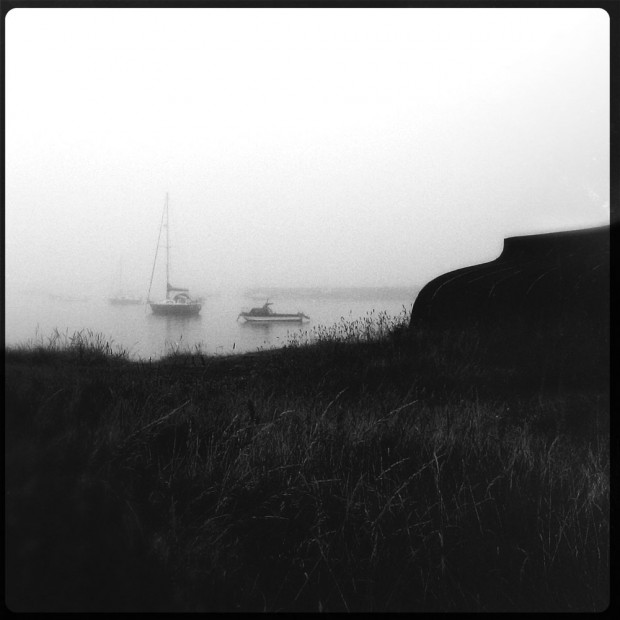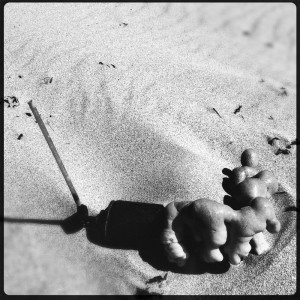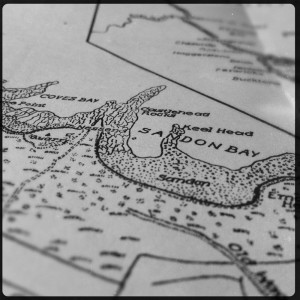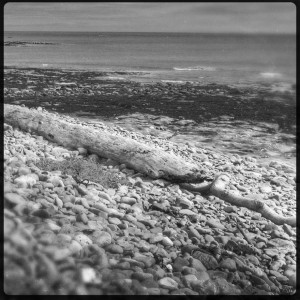You have no items in your cart. Want to get some nice things?
Go shopping
When a kite is flown underwater it is called a drogue. A drogue is a device that can be attached to the stern of a boat, giving extra stability in rough seas. Billowing socks of nylon, great woven baskets, chains or tyres are used with varying degrees of success to create drag and prevent vessels from rushing headlong into the well of a wave. Used in such a way they are something between an anchor and a parachute. Some variations work better than others; tyres and all but the longest lengths of chain are pretty ineffective as drogues, though their usage persists. At high speed, tyres scud on the surface of the water without catching, as anybody who’s ridden one in the wake of a speedboat knows. Chains, though weighty, flay the water with no appreciable drag. Such drogues are no more than talismans dragged in the wake of faithful but foolhardy ocean-goers.
A bucket tied to a nylon rope can be used to steer a yacht in a desperate moment. Swung from port to starboard and back again, the drogue becomes navigator-saviour. In all these forms—parachute, talisman, saviour—the drogue is tethered, a bound object. It exists to be a drag. It was made to be in conflict with its surroundings. But to set a drogue free, to redefine it, all you need to do is tie it to something smaller—not a boat or even a rowboat, but a fisherman’s buoy, say. Something small enough to let the drogue exist on its own terms. In this liberated state, a drogue will read the ocean rather than fight it. It will drift with currents and reveal their subtleties. Such a drogue, laden with scientific equipment, transliterates the movement of the seas. It is a balloon let go. We have satellites now that detail the ocean from a hundred miles up. Their data can be bound up and extrapolated with mathematics, but drogues are still invaluable for mapping the world’s currents.
The broadcaster Jonathan Meades once said he was “forever bewitched by objects carried on the wind” and, for some of us, things that drift have a similar allure. In 1992 a shipping container plunged into the sea, disgorging its cargo of 29,000 plastic ducks. In the two decades since, enthusiasts and scientists have tracked the ducks as they have washed up on the shores of Hawaii, Alaska, Scotland. Plastic ducks have been frozen in the Arctic ice and plastic ducks have revealed the three-year cycle of the Bering Sea. Plastic ducks have contributed more to the pool of human knowledge than you will, probably.
The desperate search for Malaysia Airlines flight MH370 has once again brought into focus how much stuff is drifting in the world’s oceans. The flotillas of shoes, plastic detritus, cargo crates—lost in storms or jettisoned empty—as well as, yes, ducks, are a disaster for the environment and a hindrance to search and rescue teams. Dead whales are cut open to reveal bellies full like rubbish trucks. Satellites take the whorls of junk to be the fuselage of a downed aircraft. And yet there is something about this scrap that delights, that fascinates, because our trash reveals the invisible. A plastic bag on the wind delineates the force that carries it and a shoe washing up in Argentina can explicate the very ocean.

I know what I can hold in my hands, though, so in the liminal zone between sea and sand dunes I can rediscover something of what my laptop understands (but it comes to me as intuition, not knowledge). I can turn things over and glean something of their origins, or I can fictionalise them altogether. It doesn’t matter as long as the thoughts stay in my head. I have words such as flotsam and jetsam, and I can try to apply them, though two words are not enough for all the ways that things end up in the sea. I would like a word for something that has been swept off the land and deposited elsewhere and I’d like a word for things that were released into the water with purpose only to be lost.
There is an island called Lindisfarne that sits on England’s shoulder as if even it had been dropped there in a winter storm. It is an island of driftwood and detritus and to stand on one of its beaches is to get a sense of the forces that form currents and let only shipwrecks and whale carcasses lie still for any length of time. The beaches between Lindisfarne and the mainland—which at low tide become a causeway, allowing temporary access—have such a high ratio of pottery to shells and pebbles that they seem to have been curated. Pieces of pottery, with their birthplace baked into them, reveal that those beaches gather centuries of junk from Berwick-upon-Tweed and Aberdeen. I used to think it strange to live on such a small island awash with the waste of great northern towns and cities.
You seldom find driftwood on the beaches of crockery, which are located on the western shore, near the island’s only village. The crockery beaches are good for an idle afternoon of littoral archaeology before vacating the island ahead of the incoming tide, or fleeing its atmosphere of isolation as soon as the tide draws back. Head to the northern shores for the driftwood beaches, where you will not find a single piece of stoneware, although you might find the ribs of a lobster pot or a yellow plastic crate from the deck of a fishing boat. The island sorts the sea, separating objects carried along the seabed from those borne on the waves. Pot and china for one side, wood for the other. I am an archaeologist by training but I much prefer the driftwood. You can burn driftwood.
The first fire I lit on Lindisfarne was in the lee of a huge tree trunk caught on rocks. I had taken the day’s newspaper for tinder and a book to read. My shift had finished late so the night was drawing in as I scoured the beach for kindling and fuel to last an hour or two. I built the fire clumsily and had even bought some firelighters from the village shop, having no faith in my own abilities. It felt wrong but I sent the whole box up in flames. The book I had with me was a history of blood feuds in medieval Northumberland. Red wedding stuff. I didn’t read much of it. I could see two castles without turning my head: Lindisfarne Castle up on Beblowe Craig and, five miles south, Bamburgh. Majestic and seemingly ancient as this skyline was, I knew that both castles had been heavily augmented by Victorians and Edwardians chasing visions of Camelot. And yet from where I sat they looked battle-ready. Cheap orange floodlights, by a trick of distance, seemed to flicker like torches.
I tried to focus on the sea and summon images of incoming longboats. At that latitude the North Sea is almost as wide as it gets. On the coast of Kent you can almost feel France, just over the horizon. On Lindisfarne I stretched out my mind for Denmark and felt nothing. Maybe it was a night-time thing because, conversely, during the day I could never shake the impression that ships lining the horizon could see amazing things hidden from me. In the end my thoughts fell and settled—no idea why—on the myth of big cats roaming free in England. My mind worked a grain of fear into a hard little pearl. In the long grass beyond the beach I could see the tapetum lucidum—the eye shine—of approaching predators. I fled without even dousing the fire, which I felt shabby about even though it posed no danger from its position below a lip of rock. When I turned back to see the fire’s glow, I was sure I could make out the shapes of creatures moving around it. Exploring the island in the following weeks I realised I’d been lucky to find a fire’s worth of driftwood on the shore by the castle. Most of it was to the north, combed out of the water by the rocks of Castlehead and Back Skerrs into Sandon Bay and Coves Haven where I lit fire after fire, alone or with friends, and could always count on finding more.

Every piece of driftwood is a stroke of luck. Wood can’t float forever — depending on the size and the grain even the biggest trunk will likely sink within two years. Two years adrift! I think of all the things I have done in two years but it doesn’t seem to compare. Most of the driftwood washing up on Lindisfarne was probably younger, of course. The inundation of that shore with broken limbs and boles summoned images of devastated coastlines elsewhere. Something was tearing up whole trees and throwing them into the sea. Trees aren’t stamped with their origins like stoneware so I could only guess where they came from. I supposed the debris was washing down from Scotland, spewed from the Tay and the Forth, Orkney and the Shetlands. From the tip of Castlehead Rocks looking north—and just a little east to skirt Peterhead—there is nothing until you come to the Shetlands, and I wanted communion with those distant islands. Had the Fair Isle current also gathered in offscourings from Lewis and Skye? I hoped so. I would burn that, too.
I became better organised and stockpiled wood, according to type and size, in a shallow alcove at the foot of some cliffs. From beard-fine twigs I could build a fire meticulously, stage by stage. Little finger, middle finger, thumb, wrist, arm, thigh; every piece was graded by width. This is against the nature of driftwood, of course, but sensible for firewood. On daytime walks I would bury beers in the sand to be dug out at later firelightings. Jacobite. Old Tom. Bede’s Chalice. Strong ales, appropriate ales. St Aidan’s Winery at the centre of the village was magnificently well stocked. I couldn’t always find them all when I returned to the beach. Perhaps sand also has deep currents.
If grading by size is against the nature of driftwood then beach art is the very antithesis of the sea’s haphazard arrangements of lumber. Once, rounding Emmanuel Head, a friend and I came across a huge pyramid of driftwood, ten feet high, made gaudy with plastic buckets, turquoise nylon rope, litter, yellow crates, pinwheels. My friend, a resident of the island, was riled by the imposition of ego on the landscape, and I goaded him on a little. It wasn’t enough for him to dismantle the structure. That was far too much effort. We cleared the plastic junk and began to pack the sculpture with lighter wood, with tinder, with kindling. With beard-fine twigs. As we stood back to admire our revisions, it began to rain.
It rained for a week. My friend and I moved from one island pub to another, watching skeins of rainwater run confluent down the windowpanes. I found a reading room, lined with books. I stashed a radio there and finished the book on Northumbrian blood feuds. All the time I worried that we would return to find the pyre gone—swept away in a storm surge—or that the artist would return and recognise the transformation for which we had primed the work. By Friday the rain cleared. We let the pyre have Saturday to dry out, to get its affairs in order, and lit it that night.

Could passing ships make out two men on the foreshore, tending a fire that burned three times their own height? We could not get within five feet of it. We had sausages to cook, but the sticks I’d sharpened with my uncle’s penknife were too short. In the end we resorted to wrapping them up in tinfoil parcels, extra foil fashioned into a swan-neck which we could gingerly hook out with a stick. We called them sausage swans. We shouted out folk songs such as Sovay and Lord Ronald, and laughed at our own ingenuity. We drank mead, actual mead. Behind us the sea continued to disgorge weary relics at the end of their voyage. Just shy of waterlogging, just short of becoming lagan. Some pieces would be covered by sand and find peace. Dark, dull peace. Others would be fixed in furniture or wall hangings and sold in shops smelling of incense, or on Etsy. The lucky junk would go up in smoke to continue to drift, to rise, to mingle with other airborne particles, bacteria, Saharan sand—particulate drogues mapping infinite permutations—to come down on our cities and towns, to raise alarm, to be breathed in, and coughed out.


About James Field
James Field is the Book Reviews & Online Essays Editor at Litro and is also the editor of a children's literary journal, Lamplands. He currently finds himself in London where he is reconciliatory. His typing speed is 65 wpm, he has 25 Steam achievement points, and he has recently become comfortable with swearing around his family.




